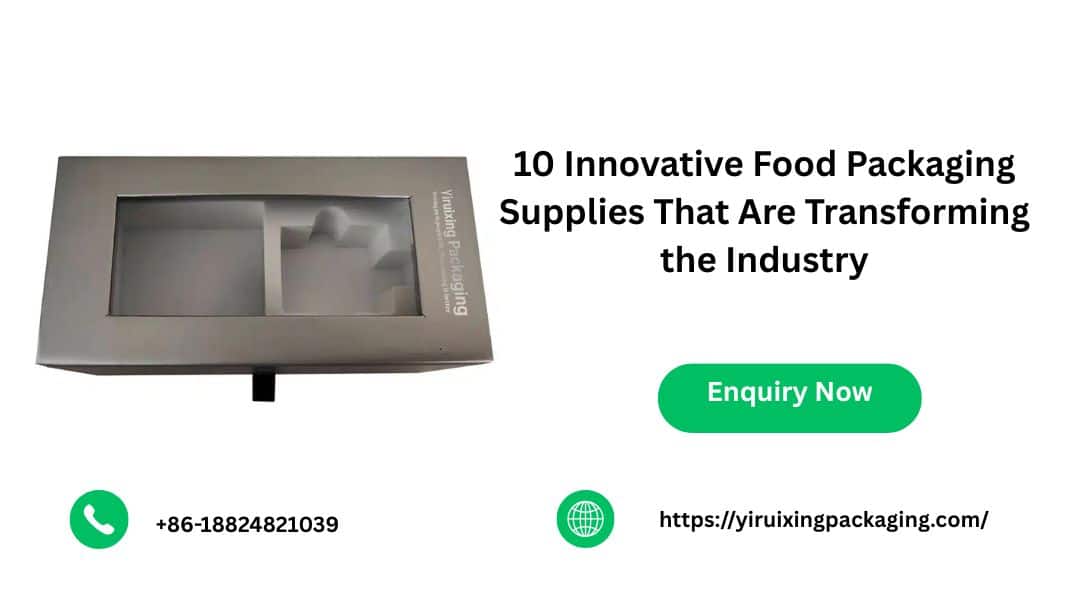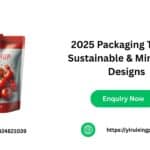10 Innovative Food Packaging Supplies That Are Transforming the Industry – The food packaging world is evolving rapidly, not only in appearance. The current perceptions of the modern world are transforming the way food is preserved, transported, and even experienced. A new generation of packaging is being propelled by sustainability, digital connectivity, and consumer convenience, and does so much more than maintaining the food fresh. Fortune Business Insights indicates that by 2024, the global food packaging market had a value of USD 505.27 billion, and the forecasted market size is USD 815.51 billion in 2032, with a 6.26% CAGR. According to Grand View Research, the market is expected to grow similarly, reaching USD 562.38 billion by 2030. At such a speed, it is evident that packaging is taking the stage in the food industry.
Table of Contents
ToggleThese are 10 Innovative Food Packaging Supplies That Are Transforming the Industry, currently – smart sensors to compostable containers – and why it is so significant to the brands interested in the custom food packaging and sustainability.
1. Smart, Sensor-Enabled Packaging
What about having your milk carton notify you that it can soon go out of date, or your salad bowl recording the temperature on the way? This is what is being made possible by smart packaging.
Smart packaging today is implemented with sensors, NFC, and QR codes embedded to control freshness, avoid spoilage, and share information with consumers. In a new arXiv study, a battery-free, wireless system that can automatically activate freshness signals when food quality deteriorates was described.
By 2030, the smart package industry will reach USD 37.5 billion.
Why it is important: It reduces waste, enhances safety, and enables brands to add value with tech-based custom food packaging.
2. Active and Modified-Atmosphere Packaging (MAP)
Extending the shelf life of food is not only good for consumers but is also a significant success for sustainability. Active packaging modifies the internal environment to prolong the shelf life.
Oxygen absorbers will be found in snack bags, or CO2 regulators in meat trays – these inventions silently combat spoilage every day. In the world food packaging market, MarketsandMarkets recognizes MAP as one of its main sources of growth.
The importance of it is that it will save more resources, extend shelf life, and reduce waste – triple the victory of brands and the planet.
3. Compostable and Bio-Based Materials.
We no longer live in a time when sustainability is a buzzword; it has become an expectation. Compostable packaging is replacing supermarket shelves with plant-based films and fiber bowls constructed out of agricultural waste.
MDPI estimates that of all materials used to package food in the world, over 40% of all materials are used in food. That is massive landfill waste minimization.
Why it is important: Compostable custom food packaging allows the brands to be green but in a nice and trendy way.
4. Recyclable and Mono Material Designs
Recycling in the past used to be cumbersome, as packaging used to be a mixture of several materials that were not separable. This is what is being changed today by the innovators.
Mono-material packaging – consisting of a single recyclable material – is simpler to work with and less expensive to recycle. Paperboard cartons, mono-polymer pouches, and recyclable barrier films are all on the rise.
The reason why it is important is that recycling can be simplified to assist the brands in complying with new regulations and improving their green reputation.
5. Stand-Up Pouches and Flexible Pouches.
When you have observed an increase in the number of food items that are packed in resealable pouches in the recent past, then you are not dreaming. The flexible packaging has gone bang and has contributed over 44 percent of the market share in 2024.
It is light, personalizable, and suited to hectic and mobile lifestyles. In addition, it needs less space and material when shipping, which minimizes the carbon footprint.
Why it is important: It is viable, sustainable, and economical. One can even use a custom stand-up pouch as a mobile billboard of your brand.
6. Edible and Dissolvable Packaging
Yes, you have read it correctly, now you can eat your packaging. Other companies, such as WikiCell, have been leading in edible films and coatings that envelop items of food such as ice cream, smoothies, or condiments.
It remains a niche innovation, yet the potential is gigantic. None of the waste, none of the plastic, and an individualized experience of the consumer.
Why it is important: Edible packaging is as sustainable as it is novel – something that environmentally friendly customers can literally bite into.
7. Anti-Counterfeit Technology and Traceability Labels.
Consumers would like to understand the origin of their food and the contents of their food. This is the reason why traceability packaging (QR codes, RFID tags, blockchain records, etc.) is rapidly expanding.
According to the results of the research conducted by Innova Market Insights, one out of every four Asian consumers is already aware of interactive or smart packaging. Transparency instills confidence, particularly in luxury or imported products.
Why it is important: It will help to calm down the buyers, discourage imitation, and open new horizons in the interactive packaging of the food.
8. Self-Cooling and Self-Heating Containers.
Self-heating and cooling packaging is perfect when people are either in camp or you have been traveling without knowing how to heat their lunch, because it is self-heating and cooling, so you can have your lunch at the right temperature.
These products transform convenience, whether it is the warming cup of noodles or the cooling drink that chills immediately.
Why it is important: Brings comfort and something new – something that consumers in the current market enjoy, but your brand remains distinct.
9. Minimalist and Lightweight Packaging.
Less can be more. Through thinner coatings, stackable trays, and better-shaped designs, the brands will be able to cut down on the costs and enhance sustainability.
Flexible formats are environmentally friendly and, most importantly, they are very efficient during storage and shipping. Lightweight packaging is one of the major growth indicators that are enumerated by Grand View Research.
Why it matters: It cuts down on material consumption, emissions, and expenses – and at the same time, it has a high shelf appeal.
10. Custom Food Packaging and Brand-Focused Design.
Lastly, bespoke food wrappings have turned into a narrative element. Brands are relying on colors, textures, and sustainable materials to appeal to the emotions of consumers.
Imagine a luxury chocolate box that opens as a gift or a simple salad box made of recycled bamboo fibre. Fortune Business Insights points out that the global market will have overtaken USD 815 billion by 2032; hence, making an impression through design is no longer a choice.
Why it matters: Custom packaging has combined functionality, sustainability, and brand identity in one potent message.
Conclusion
Food packaging is not just about protection anymore – it is about connection. The brands leading the charge are the ones combining sustainability, technology, and creativity to make packaging part of the story. Whether it is a smart label, a compostable pouch, or an edible film, each innovation brings us closer to a world where packaging enhances both the product and the planet.
FAQs
What are food packaging supplies?
Materials and technologies used to protect, store, and display food – from simple containers to advanced custom food packaging solutions.
Why is innovation in food packaging important?
It reduces waste, extends shelf life, and supports sustainability – crucial since food packaging makes up over 40% of global packaging use.
How does custom packaging benefit food brands?
It helps brands stand out, boost value, and build trust with eco-friendly or tech-driven designs.
Are sustainable materials more expensive?
Slightly at first, but they cut long-term costs and attract eco-conscious consumers.
What is next for the food packaging industry?
More recyclable materials, smart sensors, and traceable custom packaging to meet growing sustainability demands.





